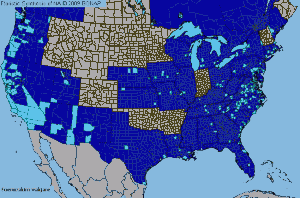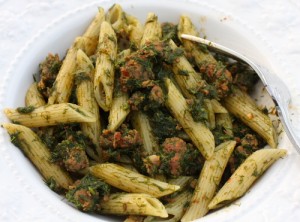
Collecting Fennel Pollen, photo by the Pollen Ranch
One of the outstanding sensory experiences of hiking in Greece is smelling the wild herbs one usually buys in little plastic containers. Thyme makes a strong aromatic presence. And while the nose does not notice Wild Fennel the eyes do. It can grow dramatically tall. I was in southwestern Crete to hike Samaria Gorge when I first saw this wild fennel in its native habitat.
Home to the Mediterranean basin, Wild Fennel (Foeniculum vulgare) is naturalized over much of the temperate world including North America. Its preferred habitat is rocky shores and adjoining hills making little distinction between rock crevasse or a crack in the road. In other parts of the world we find it growing in empty lots, beside the road, in fields, on hillsides and ocean cliffs.
Very hardy, green fronds sprout in the spring from last-year roots. They grow until fall producing tall cane-like stems. Blossoms are an explosion of yellow. It can reproduce by seed or root. As roots have been mentioned Wild Fennel is not the fennel you buy seasonally in the grocery store. Cultivated fennel has a large, edible bulb and nearly flavorless greens. Wild Fennel does not produce a bulb but has flavorful greens and seeds. If you like the flavor of sweet licorice you will like fennel. Preparation is easy: To cook the young fronds bring a large pot of water to roiling, boil the fronds for 10 minutes or so, drain, use whole or minced. You can also save the cooking liquid for flavoring.
The cooked fronds are used in several ways. Some folks eat the fronds mixed in with other greens. They are a bit overwhelming on their own. They are used with pasta as in pasta con sarde or added to soups for flavor. The seeds are used to flavor olives and most of us have tasted fennel seeds in sausage. Medicinally Wild Fennel has been used to treat colic, gas, and upset tummies. It also increases milk production in nursing mothers
From a foraging point of view Wild Fennel fronds resemble dill; thin, feathery, and brightly green. The leaves, however, are usually a light yellow green occasionally a bluish purple. You should know there is a distant relative to Wild Fennel that is deadly, the Poison Hemlock. Don’t get them mixed up. Wild Fennel has a very strong licorice aroma. Poison hemlock does not. Also Poison Hemlock has large leaves and the veins on the leaf terminate between the teeth. Wild Fennel leaves are much smaller and the veins do not terminate between the teeth.
Wild Fennel is naturalized in isolated areas in most of the United States and Canada except the high plains states and middle Canada. It is particularly common in California where it has been established for well over 120 years. It’s an invasive “weed” in southeastern Australia and parts of western Australia.
Linguistically Foeniculum is from Dead Latin’s foenum which means ‘hay’. It’s a reference to the sweet smelling plant. Vulgare is also from Dead Latin meaning ‘common.’ Foeniculum vulgare is said fee-NIK-yoo-lum vul-GARE-ee. “Fennel” comes from the Old English fenol or finol which is from the same Dead Latin feniculum or foeniculum which is a diminutive of fenum or faenum, again hay.
There are certainly hundreds if not thousands of ways to use Wild Fennel, and its domesticated relative. Still, it is difficult to find better uses than those developed over time by native foragers and passed down through the family. Here’s a tasty Italian recipe by Rosetta Constino, chef, author. Visit her site.
Pasta con Finocchietto Selvatico e Salsiccia
by Rosetta Constino, 2006
Penne with Wild Fennel and Sausage
1/4 pound (115 grams) wild fennel fronds, leaves and slim, tender stems only
3/4 pound (350 grams) fresh sweet or hot Italian sausage or Fresh Homemade Fennel Sausage Calabrian Style
1/4 cup (60 milliliters) extra virgin olive oil
Coarse salt
1 pound (450 grams) penne rigate or rigatoni
Wash the fronds well in hot water as they can harbor small insects. Bring 5 quarts (5 liters) of water to a boil in an 8-quart (8-liter) pot over high heat. Add the fronds and boil 10 minutes, then lift them out of the water and into a colander, reserving the water to cook the pasta. Drain the fronds well and finely mince. You should have 1/2 to 2/3 cup minced greens.
Remove the sausage from its casing. Break the sausage into small clumps with a table knife.
Heat the olive oil in a 10-inch (25-centimeter) skillet over moderately high heat. Add the sausage and cook until it is no longer pink and begins to brown lightly. Stir constantly with a wooden spoon, breaking up the clumps into smaller bits. Add the fennel greens and stir well to distribute them and coat them with the oil. Season with salt. Reduce the heat and keep warm.
Add 1/4 cup (35 grams) salt to the water in which you cooked the fennel. Return to a boil and add the pasta. Cook until al dente. Set aside 1 cup (250 milliliters) of the pasta water, then drain the pasta and return it to the skillet with the sausage and fennel greens. Cook, stirring, over moderate heat for a minute or two to flavor the pasta, moistening it with some of the reserved pasta water. Serve immediately.
Serves 6
Green Deane’s Itemize Plant Profile
IDENTIFICATION: Fennel (Foeniculum vulgare) is an erect perennial herb, four to ten feet tall, with finely dissected, almost feathery leaves and characterized by a strong anise scent originating from stems and leaves. The flowers are yellow and small (one-quarter inch across), and are clustered in large, rounded, umbrella-like groups (compound umbels), roughly four inches across, that are conspicuous from April through July. During the growing season plants usually include a mixture of living and dead hollow stems (canes). Branches arise from the stems at conspicuously jointed nodes, and leaves arise both from the root crown and from the stems. Leaves sheath the stems where they meet. Seeds oblong, dorsally compressed, and ribbed. Stems: 10-20 stems originate from a basal cluster in late winter, then die back the following September-November. Leaves: petioles 2.8-5.6 in (7-14 cm) long sheaths hug the stem; leaf blades triangular-ovate in outline and 0.3-2 ft (10-60 cm) long, 1-1.3 ft (30-40 cm) wide, finely dissected into nearly thread-like segments. Inflorescence: compound umbel with 15-40 spreading-ascending rays, each 0.4-1.6 in (1-4 cm) long. Flowers: no sepals, yellow petals with narrowing tips, 5 small stamens, inferior ovary topped by two short styles. Fruits: 0.1-0.2 in (2.5-4.5 mm), oblong-ovate, dorsally compressed, with thick, prominent ridges.
TIME OF YEAR: Fronds in spring, seeds mid-summer to fall
ENVIRONMENT: Mesic locations with a Mediterranean climate from sea level to 2,000 feet. Colonizes disturbed areas, adjacent to fresh or brackish water, pastures, abandoned lots, and roadsides. Common in grasslands, coastal scrub, savannas, and the banks of creeks, estuaries, and bays. Prefers sandy, acidic soil. Can tolerate clay.
METHOD OF PREPARATION: Young fronds as greens and or flavoring, older greens and seeds for flavor. Wild Fennel pollen is also a spice. To collect it either cut off flowering heads, place in a paper bag and store in a dry place, or as with cattail pollen shake the flowerhead inside a paper bag. The first way produces dry pollen, the second way fresh pollen, a stronger flavor.







